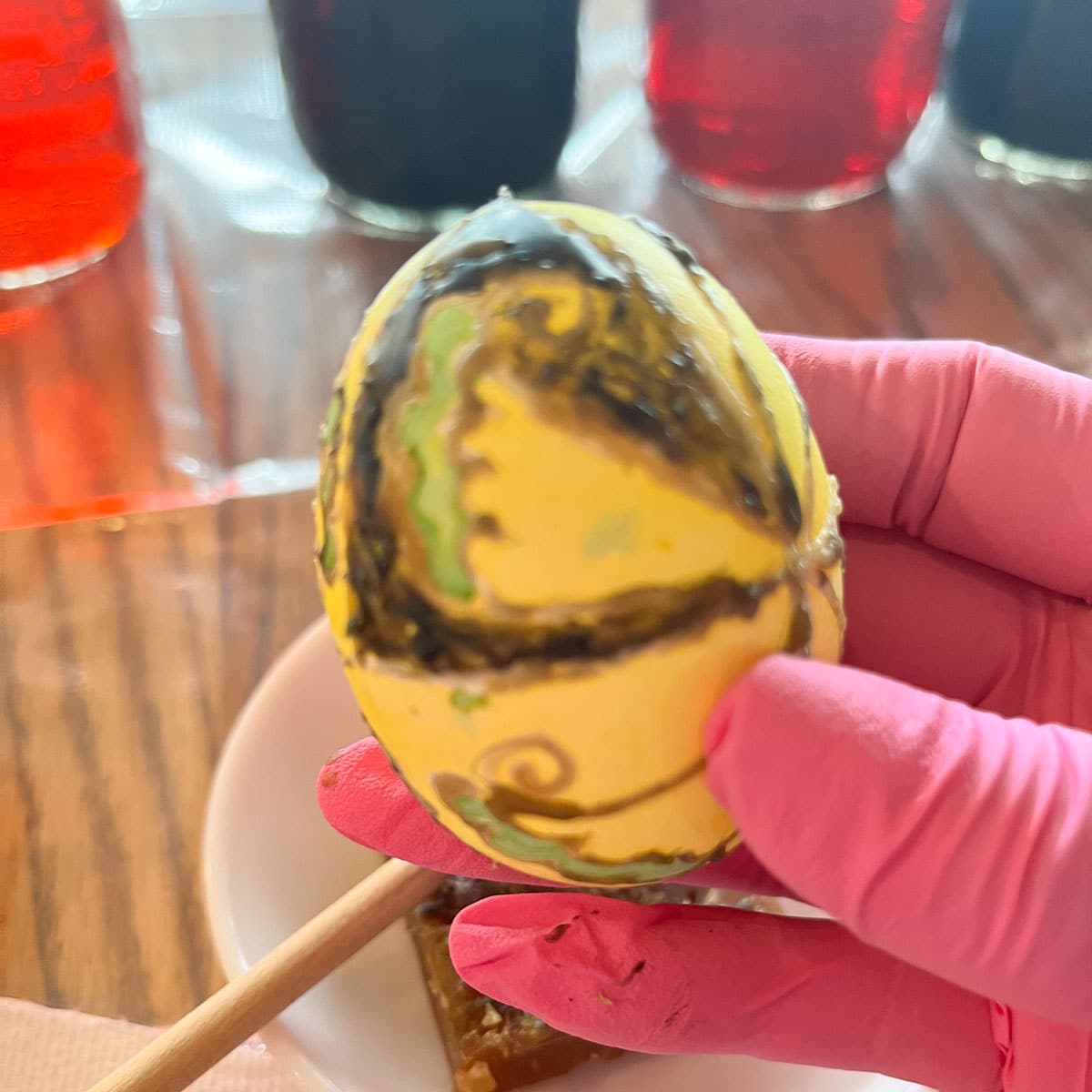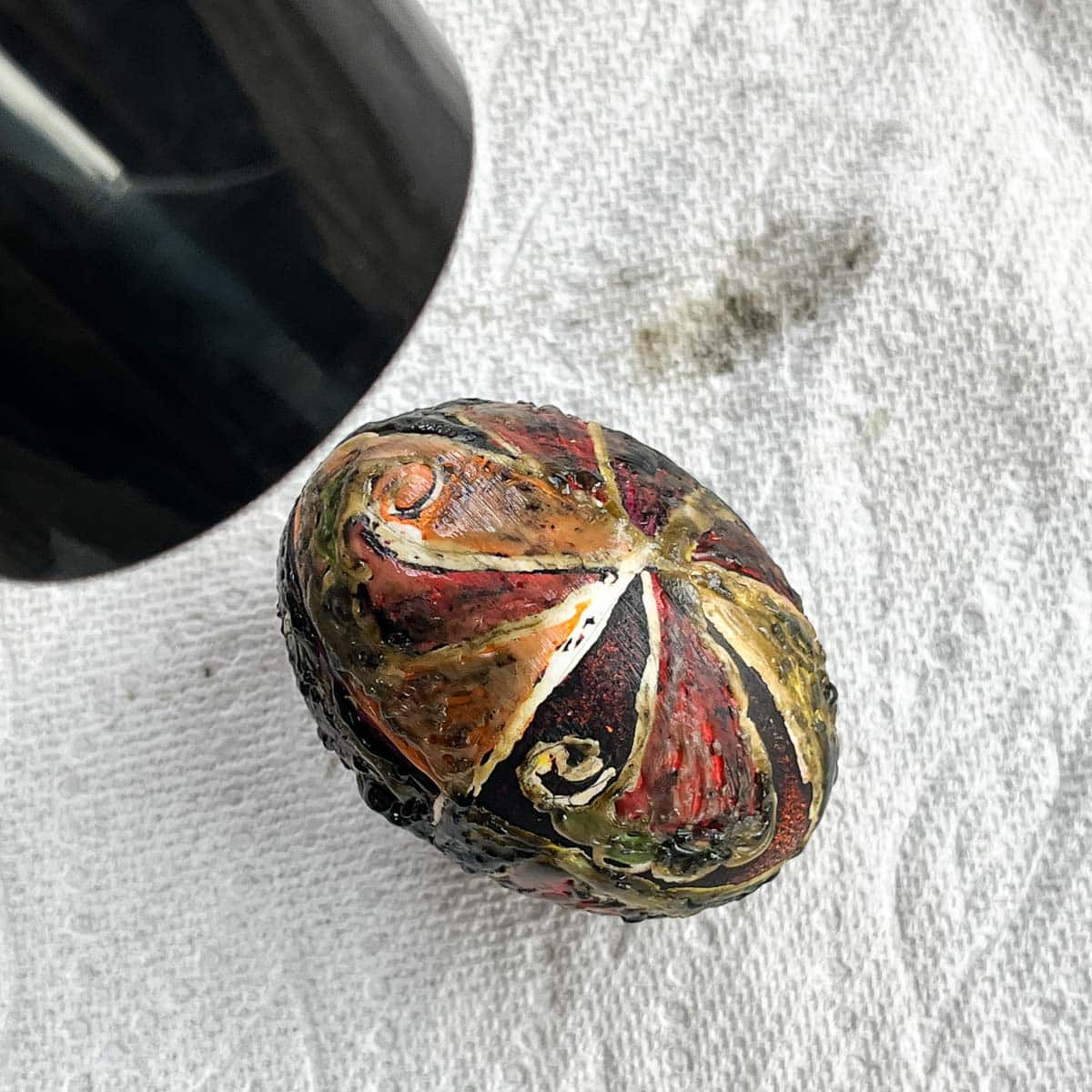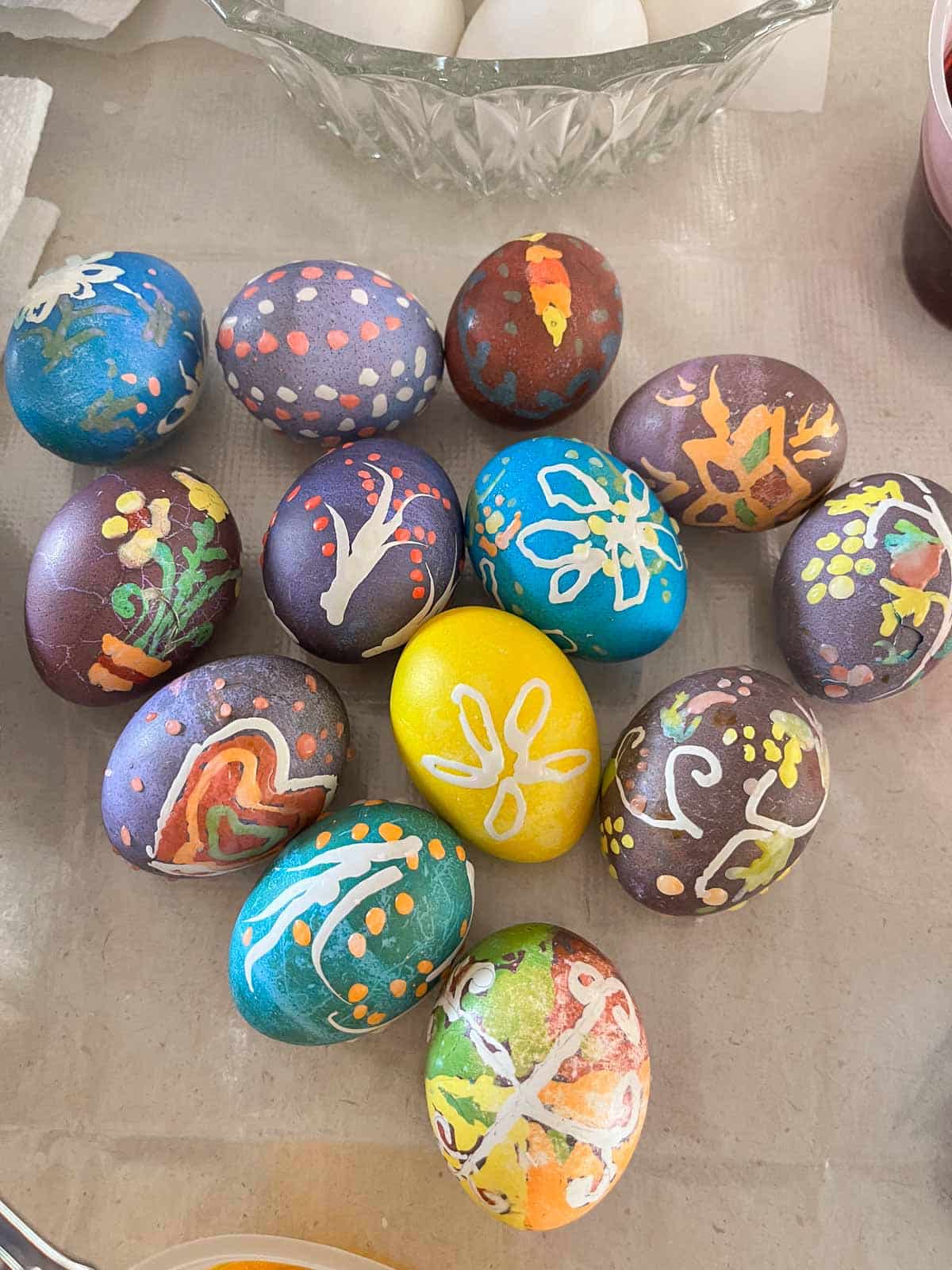It's almost Easter and this year I'm switching things up a bit with Ukrainian Pysanka eggs! Every Easter, I dye Easter eggs with onion skins like my mom and her mom before her. This year, I'm delving into my husband's Austrian side of the family, where making Ukrainian Easter eggs or pysanky eggs was a family tradition.

For a few years now, my husband's cousin, Marguerite, and I have talked about making Pysanka eggs. Marguerite's family migrated from Austria, and Marguerite, now in her 80's, recalls decorating Easter eggs with her grandmother.
So recently, while shopping in a resale shop in San Diego with my daughter, Nena, I came upon a vintage Ukrainian Easter egg decorating kit. It was the sign I needed to finally make Pysanka eggs!
If you're not artistic, don't panic, all you really need is a steady hand. Your eggs don't need to look like the ones pictured above (when you see my eggs, you'll know what I mean)🙃. Just have fun! Like anything else, your skills will improve with practice!
As it turned out, Marguerite's wax-resist method was different than the traditional Ukrainian way of making Pysanky eggs. Instead of heating the writing tool to scoop out wax, Marguerite melts paraffin wax in a tin can and dips her writing tools into it. After trying both methods, I have to say, the Ukrainian method is a lot more precise.
Jump to:
🧐 What Are Pysanky Eggs?
Pysanky (peh-san-keh) is derived from the Ukrainian verb "pysaty" meaning "to write." These intricately decorated eggs are created using "batik" which is a wax resistant method of dying eggs. The eggs are dyed while raw, and sometimes hollowed out using a small hole drilled into both ends of the egg. The holes are eventually plugged with wax.
Ukrainian Easter Eggs (Pysanka or Pysanky, plural) are a popular form of folk art. The symbols adorning the eggs used to be rooted in pagan beliefs and date back to pre-Christian times. According to folklore, these eggs were meant to drive evil spirits from the home.
In 988 AD, Christianity was adopted by the Ukrainian people and over time, the symbols took on Christian meanings, many of which represent God, Christ, or the holy Trinity. For example, a triangle represents the trinity, while a net represents Christ.
This egg dying method is popular in Eastern Europe, especially in Ukraine, Russia, Hungary, Bulgaria, Poland, and Romania. Pysanka are usually prepared during Holy Week, which is the last week of lent.
The Christians of Mesopotamia (my peeps, see what I did there?) were the first to adopt the egg as a symbol representing Christ's death and resurrection. They dyed eggs red to symbolize Christ's shed blood.
However, there are some legends suggesting otherwise. For example, one old Polish legend suggested that when Jesus was a child, his mother dyed boiled eggs to amuse him.
Another legend suggests that Mary Magdalene carried a lunch basket of eggs when she went to anoint Jesus' body. The boiled eggs were transformed to a magnificent rainbow of colors upon discovering the empty tomb.
🕯What You Need To Make Pysanka Eggs

- Eggs: Raw, clean white chicken eggs are ideal. You can also use duck, goose, and ostrich eggs.
- Vinegar: White vinegar to wash the eggs before you begin and also to add to the dyes to make them more vibrant.
- Dye: Special dyes are used to make Ukrainian Easter eggs. The basic colors include yellow, orange, light blue, light green, bright red, and black. The kind you can purchase in Easter dying kits are not intense enough but may be used to practice. You can purchase the right kind of dyes here.
- Wax: You'll need to use bees wax or spaghetti bees wax made specifically for using in the writing tool or kitska.
- Kitska: There are a few different types of writing tools to choose from. These include a traditional kitska, a delrin kistka, and an electric kistka, which makes drawing fine lines with the melted wax easier. I would start with the cheapest option before investing money in an electric writing tool.
- Spoons: You'll need spoons for gently dipping the eggs into the dye.
- Paper Towels: Paper towels or tissues will be needed for dabbing the dye off the eggs between dips.
- Misc: Tooth pics or a stylus and small brushes are sometimes used for detail work or to add dabs of color, without dipping the entire egg.
- Varnish: Varnish is optional, but does seal the egg and give it a nice shine. Choose an oil-based varnish.
- Drying Rack: A drying rack can be prepared by nailing finish nails or pushpins in a triangle to placed the egg onto to dry once varnished.
You can purchase a Kistka Pysanky kit with everything you need on Amazon.
🥚 How to Make Ukrainian Easter Eggs
Pysanka are prepared with raw eggs. The eggs can be used whole or they can be blown. If you prefer to use a hollow egg, here is how to blow out the eggs. This egg blower might come in handy. For now, I will be keeping my eggs intact.
Step 1: Prepare the eggs by dipping them in 1 cup of water mixed with 1 tablespoon of white vinegar, then pat dry. This helps the dye to adhere to the eggs
Pro Tip: You'll also need to wash your hands with soap or wear work gloves so that you don't transfer unwanted oils onto the egg shells which can create a barrier between the shell and the dye.
Step 2: Prepare dyes by following the manufacturers instructions. Using pint-sized mason jars or small bowls makes for easy dipping. Next, prepare your working surface by covering it with plastic or paper and gather the rest of your supplies (candle, pencils, wax, spoons, paper towels, etc).


Pro Tip: The instructions included in my kit said to add the entire packet of dye (I used ½ because I'm a rebel) to 1 ½ cups of boiling water, along with 1 tablespoon of white vinegar. The dyes need to cool being used.

Step 3: Begin by deciding what you will draw (whether religious motifs, nature symbols, or other pysanky designs). Draw your design on the egg using light pencil marks. Dividing your egg into quadrants makes it easier to plan out the design and keeps it more symmetrical.

Pro Tip: Since this was my first time doing this, I went a little darker than I should have.
Step 4: Next, heat the kitska funnel (writing tool) over a candle flame until hot, and scoop some wax into it. Working quickly, trace over the parts you want to remain white, heating the tool and getting more wax as needed. Hold the kitska at right angles with the egg as you apply the wax lines.




Pro Tip: This art takes a steady hand (as seen in picture below) and a lot of practice... I need lots of practice!

Step 5: Next, using a spoon, gently lower the egg into a jar of the lightest colored dye (yellow) and soak for 5 minutes. Gently dab the egg with paper towels, then cover the parts you want to remain yellow with hot wax.


Step 6: Dip the egg into the next lightest color (for example, orange) until the desired shade is achieved. Wipe dry and cover the parts of the pattern you want to remain orange. Continue with these steps until you have dyed the egg with the darkest dye, in my case, black.




Step 7: To melt the wax off and reveal your colorful creation, use a hair dryer or hold the egg perpendicular to an open flame while rotating and wiping the egg until all the wax is removed.


Pro Tip: Never hold the egg directly over a flame, which will blacken the egg. A gas stove is a great option!

Pro Tip: You can easily make a tripod with push pins to use as a stand, especially to dry varnished eggs.
🔆 Ukrainian Egg Symbol Meanings
Christian women begin the process of making Ukrainian pysanka eggs by making the sign on the cross and whispering "God help me." This is said to bring the meaning behind the symbols come to life for the ones who receive or see the Pysanka eggs on Easter morning. Interestingly, my mom did the same every time she began to cook.
- Ribbon or Belt: A line around the egg signifies eternity. Ribbons represent water.
- Dots & Small Circles: These represent the constellations. They also represent the tears of the Virgin Mary at Chirst's crucifixion.
- Nets: Christian symbols for Christ or fishing for men.
- Traingles: Holy trinity
- Ladders: Prayers going up to heaven
- Curls/Swirls: Represent protection
- Diamonds: Knowledge
- Pointed Stars: Symbols for Christ
- Crosses: These represent Christ's suffering, death, and resurrection or the 4 corners of the world.
- Hens Feet: Protection of the young
- Leaves & Flowers: Love, life, growth
- Pine Needles: Youth, health, and stamina
- Fish: Another common symbol for Christ
- Deer & Horses: Wealth and prosperity
- Birds: Fertility and wishes answered. Birds are always in a resting position, never flying.
- Grapevine: A Christian's "good fruits"
- Grapes: Communion and growing the church
- Butterfly: Resurrection
- Stars: God's love towards us
- Sieves: Separating good from evil
- Rams Horn: Strength, leadership
- Wheat: Good health, good harvest
- Sun: Love of God
- Spider Web: Patience and skill
- Wolf's Teeth: Loyalty, wisdom

🖌 What do pysanka egg dye colors represent?
Not only do the symbols have a meaning, but so do the colors used to dye the eggs. Here's a short list of colors and what they represent:
- White: Purity, innocence, birth
- Yellow: Youth, happiness, wisdom
- Orange: Strength, the sun
- Pink: Success
- Red: Happiness, passion, the sun
- Green: New growth, spring time, hope
- Blue: Sky, good health
- Purple: Fasting, faith, trust
- Black: Eternity, darkest hour before the dawn

🤷🏻♀️ FAQs
No, Pysanky eggs are decorated while raw. The egg can be in tact or can be blown out so that they're hollow. Traditionally, the eggs are kept intact because the egg yolk represents life.
Pysanky eggs can last indefinitely if stored carefully in a cool, dark, location.
Generally you want to go from the lightest color to the darkest. Yellow is usually the first color, followed by light green, light blue, orange, pink, red, and brown. The final colors are usually purple, dark blue, dark green, and black.

👩🏼🍳 Pro Tips
- Make sure your eggs are room temperature, otherwise the wax may not stick to them.
- It's helpful to make a grid pattern on the eggs for symmetry.
- Not sure what to draw on your Ukrainian Pysanka eggs? Try searching online for design ideas or get yourself this Pysanky for Beginners guide.
- Overheating the kitska or adding too much wax can cause blobs of wax to land on your egg and ruin your design.
- Thick elastic bands can be used to draw straight lines onto your eggs.
- Planning your design along with the desired colors on paper first makes is much easier to follow when you work on the egg itself.
- Drawing on both sides of the egg allows you display the best side, especially if you mess up on one of the sides. Yes, I speak from experience!
- When wiping the wax off, do it gently as to not break the finished egg. Yes, I did that too.
- Ukrainian Pysanka eggs make a lovely addition to your Easter table décor!
Still hungry for more Pysanka-related information? Make sure you read this interesting article on the History of Pysanky.

🥕 Related Recipes
If you've enjoyed this Ukrainian Pysanaka eggs post, you may also be interested in my Ukrainian Stuffed Cabbage and Borscht recipes!
Love this recipe? Please leave a 5-star 🌟🌟🌟🌟🌟rating in the recipe card below & a review in the comments section further down the page.
Stay in touch with me through social media @ Instagram, Pinterest, TikTok, and Facebook. Don't forget to tag me when you try one of my recipes!






Comments
No Comments